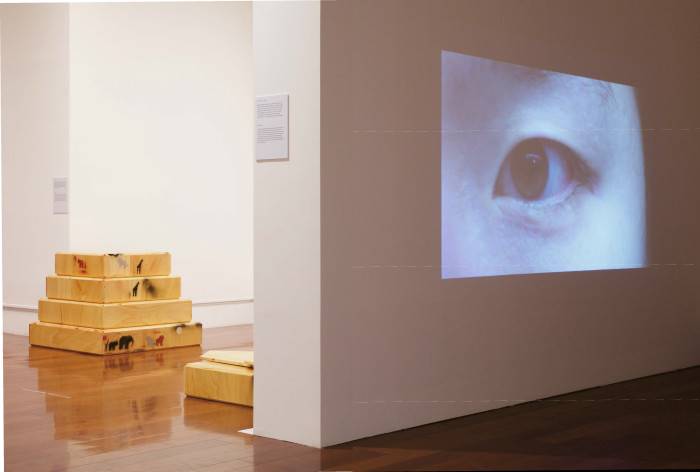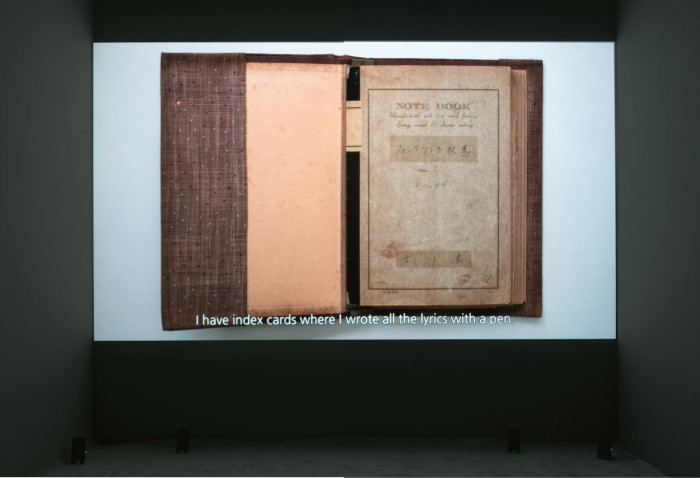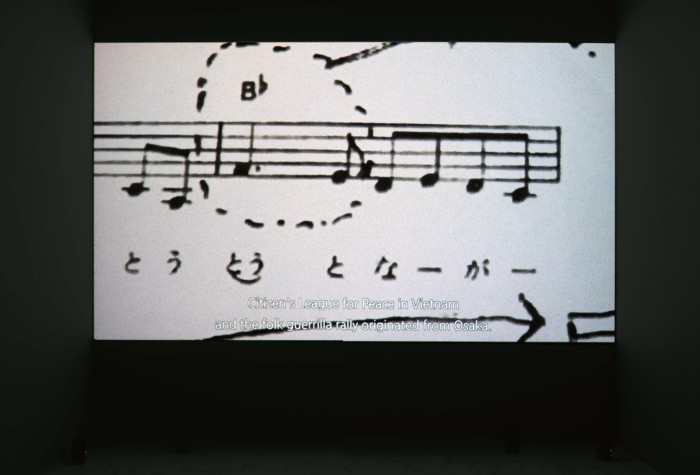GyeongGi Cultural Foundation
The Mystery of the World: Hwayeon Nam, Adoration of the Magi
Gyeonggi Museum of Modern art
This catalogue is published in conjunction with 2017-2018 Korea–Germany Contemporary Art Exchange Exhibition Irony & Idealism. It documents all exhibitions and artworks at 3 venues in Korea and Germany-Gyeonggi Museum of Modern Art, KF Gallery and Kunsthalle Münster-from September 2017 until September 2018.
|
Hyun Siwon
Co-director of Audio Visual Pavilion, Curator
Artist & Artwork - Hwayeon Nam
Hwayeon Nam’s Adoration of the Magi (2015) treats mysteries of the world in a chilling way. The work begins with two facts. The artist understands something about the famous name “Giotto.” First and foremost, Giotto di Bondone (1267-1337) observed Halley’s Comet and described it as a red twinkling fireball in his Adoration of the Magi. He saw Halley’s Comet with his naked eye in 1301 and this ruby grapefruitcolored comet provided the inspiration for the Star of Bethlehem at the top of the painting. When Nam gazes at Giotto’s star through the camera lens, the painted star is materially transformed into a flat image. At the content level, the star is also transfigured into a particular object, an oscillation between religious mystery and scientific exploration. Although Giotto did not understand the star as Halley’s Comet, we remember him as the first to create a scientific drawing of Halley’s Comet.
Another fact regarding the name “Giotto” that Nam considers is concerned with a scientific mission of his posterity. Nam found that the European Space Agency had named a space probe “Giotto” and launched it to observe Halley’s Comet from relatively close at hand. She contextualized this fact into an additional axis in her work. Thus, when she says “Look at Giotto” in her video, we can find a simple yet interesting multi-layered meaning. That is to say, the name of the artist who completed a fourteenth- century fresco a in chapel is transferred onto a spacecraft produced in the late twentieth century. These two “Giottos” converge at a specific point— each referring to an explorer, one who observed Halley’s Comet and another that searched for it.

In Nam’s Adoration of the Magi, the artist’s eye(s) plays one of the most important roles: facilitating the movements between heterogeneous subjects. Opening the work, her eye appears in close-up while moving in a restrained but regular manner. Eyes are both the subject that sees and the object to be seen. Likewise, “Giotto” means the subject who drew Halley’s Comet and the object that was launched toward the same comet. Dealing with this duality (and further multiplicity) of seeing and being seen, Nam’s “image description” does not follow any chronological order or sequence of events. The clues collected by the artist simply present things that were produced through a process of misapprehending, misconceiving, and believing in Halley’s Comet. Nam simply helps the audience to feel that there has always across the vastness of human history been a desire for seeing (or looking for) something. 1Through this process, Nam treats the primal sensibility and will that have developed our vision— to see farther than before, both, horizontally or vertically— as a mystery.

In Nam’s Adoration of the Magi, we can catch this feeling of mystery. It is the sense of awe that we experience when encountering something newly emerged or partially revealed. How does Nam help us to view the as world mysterious or catch us up in the atmosphere of mystery in her work? Nam is, to be sure, dealing with knowledge. By re-contextualizing certain historical facts regarding Halley’s Comet, Nam creates for us an extension for our eyes. The artistic strategies used to juxtapose stillcuts and moving-images are minimal and resolute. Here, each historical moment is individually positioned according to the period’s research methods. For instance, when it slowly moves from right to left by following a star trailing a long tail, the comet is described as a red star with a long tail and no name (Giotto’s painting). Next, the comet is considered as an object for study by the scientist Edmond Halley (1656-1742) who observed it through a telescope and predicted its appearances based on a specific cycle (in Halley’s book entitled Synopsis Astronomia Cometicae). Transferred to Nam’s Adoration of the Magi, these historical facts surrounding Giotto are described as an entity, one which does not enter our complete awareness. Words in reference to the comet such as “grapefruit colored” or “something afar that can only be captured through a telescope” are all based upon the artist’s interpretations. Here, this can be considered “floating knowledge” that is not yet sealed into a decisive conclusion. Indeed, can we say that this kind of proto-knowledge is an event? In Nam’s work, knowledge is captured through human eyes and is therefore sensuous.

In Nam’s Adoration of the Magi, three types of seeing—through the artist Giotto’s naked eyes, the scientist Halley’s telescope, and the camera lens on the spacecraft Giotto—contrast with the eyes of Nam, which blink regularly or shift from side to side. The three different techniques for extending and developing our sight in each respective period are interconnected more intricately than a Mobius strip and structured to gaze at each other through a history of images. Regarding the structure of Nam’s work, in the beginning she shows a drawing of eyeballs, and at the end she includes “Silent Night, Holy Night” by the Winchester Cathedral Choir as background music. This juxtaposition is not about a process of comprehension—it delivers a sense of the sublime toward ignorance which wishes to explore and feel a particular unknown entity. The found footage shows the spacecraft Giotto’s launch and perpendicular ascent. We next hear the sound of applause as the spacecraft reaches orbit—this time, the applause is performative. In particular, the entire scene of the seven-second countdown immediately before encountering Halley’s Comet far from 48000 km is beautiful. This moment draws the audience’s sensuous participation as a reaction to the comet’s entering orbit toward a black planet. The numbers rushing to 0 demonstrate mechanical time, while the close-up fades in on a scene delivers the sense of tension before an explosion. This scene demonstrates a dynamic, momentary movement that washes over a sense of stillness on the screen.

In the system of belief and doubt, human eyes serve to sense an unknown object. At the same time, however, they require supplemental devices to overcome their limitations. Images available through Google seem to describe Halley’s Comet as if it exists on a flat surface without any temporal changes. However, such images (as proof) demonstrate certain achievements and errors brought about by the desires of many different individuals across time and that it was through these mistakes that the next achievement became available. In Nam’s Adoration of the Magi, the eyes are asked to serve a new mission between a method of seeing and the idea (ideal). Halley’s Comet has been viewed differently in different time periods, however, it shows parallel movement through Nam’s construction. An element A is not included into an element B, nor considered as B’s secondary; element B as an independent subject parallels element A. The name Giotto refers to a man who observed a fragment of the universe with the naked eye, and at the same time it is used in the future as a name for something that searched the universe. For an artist who describes the difference, knowing and knowledge cannot be crystalized into an existing discipline. Beyond multi-disciplinary knowledge, Nam focuses on the errors of different time periods. In this way, she gazes at a modality captured in a moment from continuous time filled with collected statements and images. The artist’s statement is indeterminate—it stimulates a curiosity to carry a new event continuously. This is one of the most important reasons why Nam’s work demonstrates a performativity for continuous curiosities rather than a juxtaposition of decisive statements.

<Copyright(c)2002 GGC All rights reserved.>
information
IRONY & IDEALISM
Publisher/ Sul Wonki
Chief Editor/ Choi Eunju
First Edition/ July 31. 2018
Published by/ Gyeonggi Museum of Modern Art
List of Artists/ Ahn Jisan, Bae Young-whan, Björn Dahlem, Gimhongsok, Hwayeon Nam, Michael van Ofen, Manfred Pernice, Yoon Jongsuk
keywords
- Writer
- GyeongGi Cultural Foundation
- About
- Everything about the GyeongGi arts and culture, GGCF
- homepage
- http://www.ggcf.kr